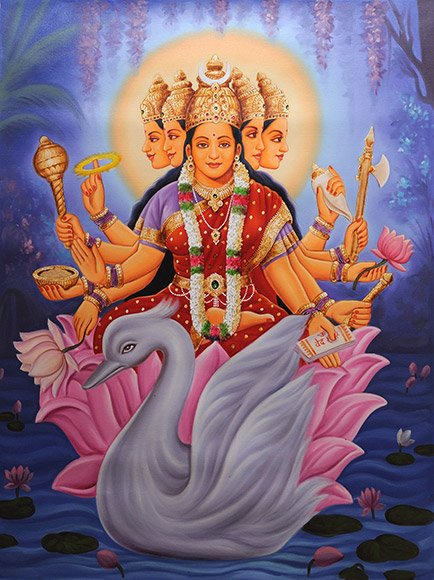Pramitakshara, Pramitākṣarā, Pramita-akshara, Pramitākṣara: 11 definitions
Introduction:
Pramitakshara means something in Hinduism, Sanskrit. If you want to know the exact meaning, history, etymology or English translation of this term then check out the descriptions on this page. Add your comment or reference to a book if you want to contribute to this summary article.
The Sanskrit terms Pramitākṣarā and Pramitākṣara can be transliterated into English as Pramitaksara or Pramitakshara, using the IAST transliteration scheme (?).
In Hinduism
Natyashastra (theatrics and dramaturgy)
Source: Wisdom Library: Nāṭya-śāstra1) Pramitākṣarā (प्रमिताक्षरा) refers to a type of syllabic metre (vṛtta), according to the Nāṭyaśāstra chapter 16. In this metre, the third, the fifth, the ninth and the twelfth syllables of a foot (pāda) are heavy (guru), while the rest of the syllables are light (laghu).
⏑⏑⎼¦⏑⎼⏑¦⏑⏑⎼¦⏑⏑⎼¦¦⏑⏑⎼¦⏑⎼⏑¦⏑⏑⎼¦⏑⏑⎼¦¦
⏑⏑⎼¦⏑⎼⏑¦⏑⏑⎼¦⏑⏑⎼¦¦⏑⏑⎼¦⏑⎼⏑¦⏑⏑⎼¦⏑⏑⎼¦¦
Pramitākṣarā falls in the Jagatī class of chandas (rhythm-type), which implies that verses constructed with this metre have four pādas (‘foot’ or ‘quarter-verse’) containing twelve syllables each.
2) Pramitākṣarā (प्रमिताक्षरा) is the name of a meter belonging to the Natkuṭa class described in the Nāṭyaśāstra chapter 32:—“the metre which has in its feet of twelve syllables, the third, the fifth, the ninth and the last long, is pramitākṣarā”.
Source: Shodhganga: Mankhaka a sanskrit literary genius (natya)Pramitākṣarā (प्रमिताक्षरा) is the name of a Sanskrit metre (chandas) of the Vṛtta-type (akṣarachandas: metres regulated by akṣaras, syllabes).—The metre, Pramitākṣarā contains twelve syllables in each and every quarter and thegaṇas are sa, ja, sa and sa. This metre is found to be employed in the Śrīkaṇṭhacarita.

Natyashastra (नाट्यशास्त्र, nāṭyaśāstra) refers to both the ancient Indian tradition (shastra) of performing arts, (natya—theatrics, drama, dance, music), as well as the name of a Sanskrit work dealing with these subjects. It also teaches the rules for composing Dramatic plays (nataka), construction and performance of Theater, and Poetic works (kavya).
Chandas (prosody, study of Sanskrit metres)
Source: Shodhganga: a concise history of Sanskrit Chanda literature1) Pramitākṣarā (प्रमिताक्षरा) is the alternative name of a Sanskrit metre (chandas) mentioned by Hemacandra (1088-1173 C.E.) in his auto-commentary on the second chapter of the Chandonuśāsana. Pramitākṣarā corresponds to Citrā. Hemacandra gives these alternative names for the metres by other authorities (like Bharata), even though the number of gaṇas or letters do not differ.
2) Pramitākṣarā (प्रमिताक्षरा) refers to one of the 135 metres (chandas) mentioned by Nañjuṇḍa (1794-1868 C.E.) in his Vṛttaratnāvalī. Nañjuṇḍa was a poet of both Kannada and Sanskrit literature flourished in the court of the famous Kṛṣṇarāja Woḍeyar of Mysore. He introduces the names of these metres (e.g., Pramitākṣarā) in 20 verses.
3) Pramitākṣarā (प्रमिताक्षरा) refers to one of the 130 varṇavṛttas (syllabo-quantitative verse) dealt with in the second chapter of the Vṛttamuktāvalī, ascribed to Durgādatta (19th century), author of eight Sanskrit work and patronised by Hindupati: an ancient king of the Bundela tribe (presently Bundelkhand of Uttar Pradesh). A Varṇavṛtta (e.g., pramitākṣarā) refers to a type of classical Sanskrit metre depending on syllable count where the light-heavy patterns are fixed.
4) Pramitākṣarā (प्रमिताक्षरा) refers to one of the seventy-two sama-varṇavṛtta (regular syllabo-quantitative verse) mentioned in the 334th chapter of the Agnipurāṇa. The Agnipurāṇa deals with various subjects viz. literature, poetics, grammar, architecture in its 383 chapters and deals with the entire science of prosody (e.g., the pramitākṣarā metre) in 8 chapters (328-335) in 101 verses in total.

Chandas (छन्दस्) refers to Sanskrit prosody and represents one of the six Vedangas (auxiliary disciplines belonging to the study of the Vedas). The science of prosody (chandas-shastra) focusses on the study of the poetic meters such as the commonly known twenty-six metres mentioned by Pingalas.
Languages of India and abroad
Sanskrit dictionary
Source: DDSA: The practical Sanskrit-English dictionaryPramitākṣarā (प्रमिताक्षरा).—f. Name of a metre having each quarter comprised of 12 syllables.
Pramitākṣarā is a Sanskrit compound consisting of the terms pramita and akṣarā (अक्षरा).
--- OR ---
Pramitākṣara (प्रमिताक्षर).—few words.
Derivable forms: pramitākṣaram (प्रमिताक्षरम्).
Pramitākṣara is a Sanskrit compound consisting of the terms pramita and akṣara (अक्षर).
Source: Cologne Digital Sanskrit Dictionaries: Shabda-Sagara Sanskrit-English DictionaryPramitākṣarā (प्रमिताक्षरा).—f.
(-rā) 1. A species of Jagati metre. 2. The name of the commentary on Muhurta chintamani.
Source: Cologne Digital Sanskrit Dictionaries: Cappeller Sanskrit-English DictionaryPramitākṣarā (प्रमिताक्षरा).—[feminine] [Name] of a metre.
Source: Cologne Digital Sanskrit Dictionaries: Aufrecht Catalogus Catalogorum1) Pramitākṣarā (प्रमिताक्षरा) as mentioned in Aufrecht’s Catalogus Catalogorum:—a
—[commentary] on Vijñāneśvara’s Mitākṣarā, by Nanda Paṇḍita.
2) Pramitākṣarā (प्रमिताक्षरा):—a
—[commentary] on his own Muhūrtacintāmaṇi, by Rāma Gaṇaka.
—on the same, by Rāmanārāyaṇa.
1) Pramitākṣara (प्रमिताक्षर):—[=pra-mitākṣara] [from pra-mita > pra-mā] n. [plural] ‘measured syllables’, few words, [Kathāsaritsāgara]
2) Pramitākṣarā (प्रमिताक्षरा):—[=pra-mitākṣarā] [from pra-mitākṣara > pra-mita > pra-mā] f. Name of a metre, [Śrutabodha]
[Sanskrit to German]
Sanskrit, also spelled संस्कृतम् (saṃskṛtam), is an ancient language of India commonly seen as the grandmother of the Indo-European language family (even English!). Closely allied with Prakrit and Pali, Sanskrit is more exhaustive in both grammar and terms and has the most extensive collection of literature in the world, greatly surpassing its sister-languages Greek and Latin.
Kannada-English dictionary
Source: Alar: Kannada-English corpusPramitākṣara (ಪ್ರಮಿತಾಕ್ಷರ):—[noun] (pros.) a variety of verse having ten syllables in each line.
--- OR ---
Pramitākṣara (ಪ್ರಮಿತಾಕ್ಷರ):—[noun] a word, limited words of speech uttered or delivered with careful thought.
Kannada is a Dravidian language (as opposed to the Indo-European language family) mainly spoken in the southwestern region of India.
See also (Relevant definitions)
Partial matches: Mitakshara, Akshara, Pra, Pramita, Pramita.
Ends with: Atharvanapramitakshara.
Full-text: Vamana, Ramanarayana, Muhurtacintamani, Nanda pandita, Citra, Rama, Rijumitakshara, Mitakshara.
Relevant text
Search found 3 books and stories containing Pramitakshara, Pra-mitākṣara, Pra-mitaksara, Pra-mitākṣarā, Pra-mitakshara, Pramita-akṣarā, Pramita-aksara, Pramita-akṣara, Pramita-akshara, Pramitākṣarā, Pramitaksara, Pramitākṣara; (plurals include: Pramitaksharas, mitākṣaras, mitaksaras, mitākṣarās, mitaksharas, akṣarās, aksaras, akṣaras, aksharas, Pramitākṣarās, Pramitaksaras, Pramitākṣaras). You can also click to the full overview containing English textual excerpts. Below are direct links for the most relevant articles:
The backdrop of the Srikanthacarita and the Mankhakosa (by Dhrubajit Sarma)
Part 4a - Chandas (1): Vṛtta type of metre (akṣarachandas) < [Chapter III - Literary Assessment Of The Śrīkaṇṭhacarita]
The Agni Purana (by N. Gangadharan)
Natyashastra (English) (by Bharata-muni)